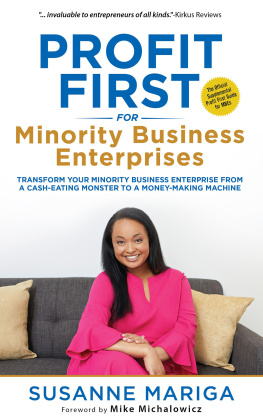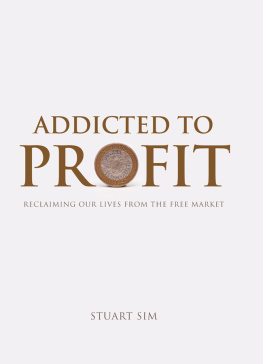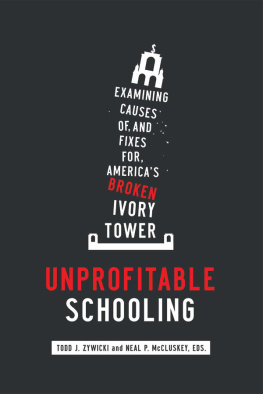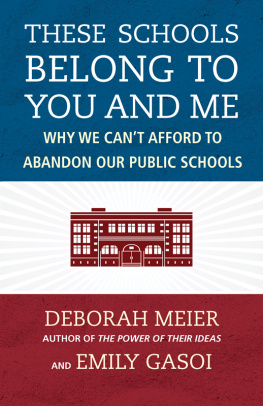Sick Schools
Diagnosis, Cure, and Prevention of School Maladies
David V. Anderson
Sick Schools
Diagnosis, Cure, and Prevention of School Maladies
Copyright 2019 David V. Anderson. All rights reserved. Except for brief quotations in critical publications or reviews, no part of this book may be reproduced in any manner without prior written permission from the publisher. Write: Permissions, Wipf and Stock Publishers, W. th Ave., Suite , Eugene, OR 97401 .
Resource Publications
An Imprint of Wipf and Stock Publishers
W. th Ave., Suite
Eugene, OR 97401
www.wipfandstock.com
paperback isbn: 978-1-5326-9686-2
hardcover isbn: 978-1-5326-9687-9
ebook isbn: 978-1-5326-9688-6
Manufactured in the U.S.A. 11/07/19
This book, Sick Schools, is dedicated to the memory of its principal agent of inspiration, Milton Friedman.
Table of Contents
Abstract
O ur story of education within western civilization starts before the printing presses of the th century. Then, most children were illiterate. Some learned in small groups or were tutored. Once printed books became more affordable, circa 1500 , more students had access to them, but the numbers of teachers were limited- for obvious economic reasons. Group instruction fixed that mismatch. Soon, graded schools with group instruction were established- not really so much different than those of our own time, almost years later.
In United States K- education, a students age was traditionally used for the initial classroom placement that could later be adjusted by retention or double-promotion to align that pupils placement with the his or her actual performance level. That has changed. Now we have social promotion in which students rise through the grade levels of a school without actually achieving grade level mastery. This means that report cards, transcripts and diplomas generally misrepresent the skill levels of students. Result: Sick Schools wherein many students perform below grade level. We have statistics for this within the United States from the Nations Report Card , which has been in business since 1970 . Reading and mathematics skills for the early st century are dire: In public schools well less than % are proficient in th grade, and by th grade less than % are proficient in both subjects. And it is much worse for history and civics. Sadly, private schools are not much better. What are the problems? Who should we hold responsible for this mess?
We could blame the teachers, books and instructional methods. And some reform efforts do that. Sometimes forgotten is the role that healthy economic incentives can play in improving things. Nobel Laureate economist Milton Friedman addressed this in the 1950 s and proposed government funded vouchers that would give parents more control over their childrens schooling. But do they work? Yes, but not all that well. Missing from that market is honest consumer information to replace the reality that schools lie to parents and others about their performance levels and other characteristics. Parents are somewhat complicit in this because they prefer hearing false good news more than the truthful bad news about their schools.
Looking deeper, there are a number of practices within schools that seem traditional, but are also corrupt and dishonest. This book discusses some promising instructional improvements, but makes the larger argument that a healthy economic marketplace for K- education is a fundamental prerequisite that will provide the incentives to develop the new methods, technologies, curricula and institutions that will, in turn, give its customers what they need and want. Given that vouchers alone, seem insufficient when parents have little accurate information about school quality, we must generate that information and get it into the right hands. We identify the culpable parties to this epidemic of sick schools and, though there are individual exceptions, no group in this list escapes responsibility: Parents, students, teachers, unions, school administrators, politicians, religious leaders and even the private sector of our economy. Finally, technological developments allow schools to be structured in more efficient styles, but it is rare to see them realized. That is ending. For-profit K- schools are coming on line. Some of them are the best in the USA. They are tuition efficient operating at about a % discount to the best non-profit K- schools. Education of our children can be less expensive and much better. We can have a new and Milton Friedman inspired Reformation of Sick Schools: The Free to Choose Reformation. To find out how, keep reading this book.
Foreword
Honest School Information Is Crucial for School Choice
S upporters of education reform who advocate government-funded choice mechanisms, such as vouchers, tend to argue the problems in our K- schools are primarily matters of economics and not directly of pedagogy. Our view, validated by much data, extends that concept and says the economic marketplace in which K- education operates needs more than vouchers to become a healthy sector of our American economy.
In recent years we have reviewed trends in the performance levels of private and public schools, as reported by the Nations Report Card, and found a modest but significant correlation between student achievement and the level of competition created by the availability of school choice in the form of vouchers and/or charter schools. Where choice exists, student performance levels are improving faster than where it is absent.
Even so, the pace of student proficiency gains has been quite slow, indicating many decades will be required for these schools to reach proficient academic performance levels.
Obviously, thats not going to be good enough, so we must seek additional ways to energize the K- marketplace. An important missing ingredient is accurate consumer information that would enable parents and others to make wise choices in the selection of schools and other educational services. Currently, most parents and other stakeholders operate in a sea of misinformation about school performance levels and other school characteristics. Public schools in every state we reviewed routinely and pervasively lie about student proficiency levels. Typically, twice as many students are deemed proficient as are reported by the well-respected Nations Report Card. In addition, proficiency numbers are not usually available at the school or district level, leaving parents and others in the dark as to the performance levels of their local schools.
Private schools, in contrast, tend to hide behind their unearned reputation of being superior to their public school neighbors. It is indeed rare to find a private school that publicizes its student performance levels. However, the Nations Report Card tells us something about the national comparisons of public to private schools: When judged by how they educate the same economically disadvantaged demographic of children, the surprising results are that public schools and private schools are tied in mathematics, with each only educating about percent of the eighth grade students to proficient levels. For reading, the private schools are somewhat better.
I believe getting good, honest school performance information into the hands of parents will energize K- school reform and bring the desired results. When parents are informed consumers, they will make better choices, and this will help invigorate the K- marketplace so the actual reforms will be nearly automatic. When this informational choice is combined with vouchers, parents and other stakeholders will know how to hold schools accountable for their results.








